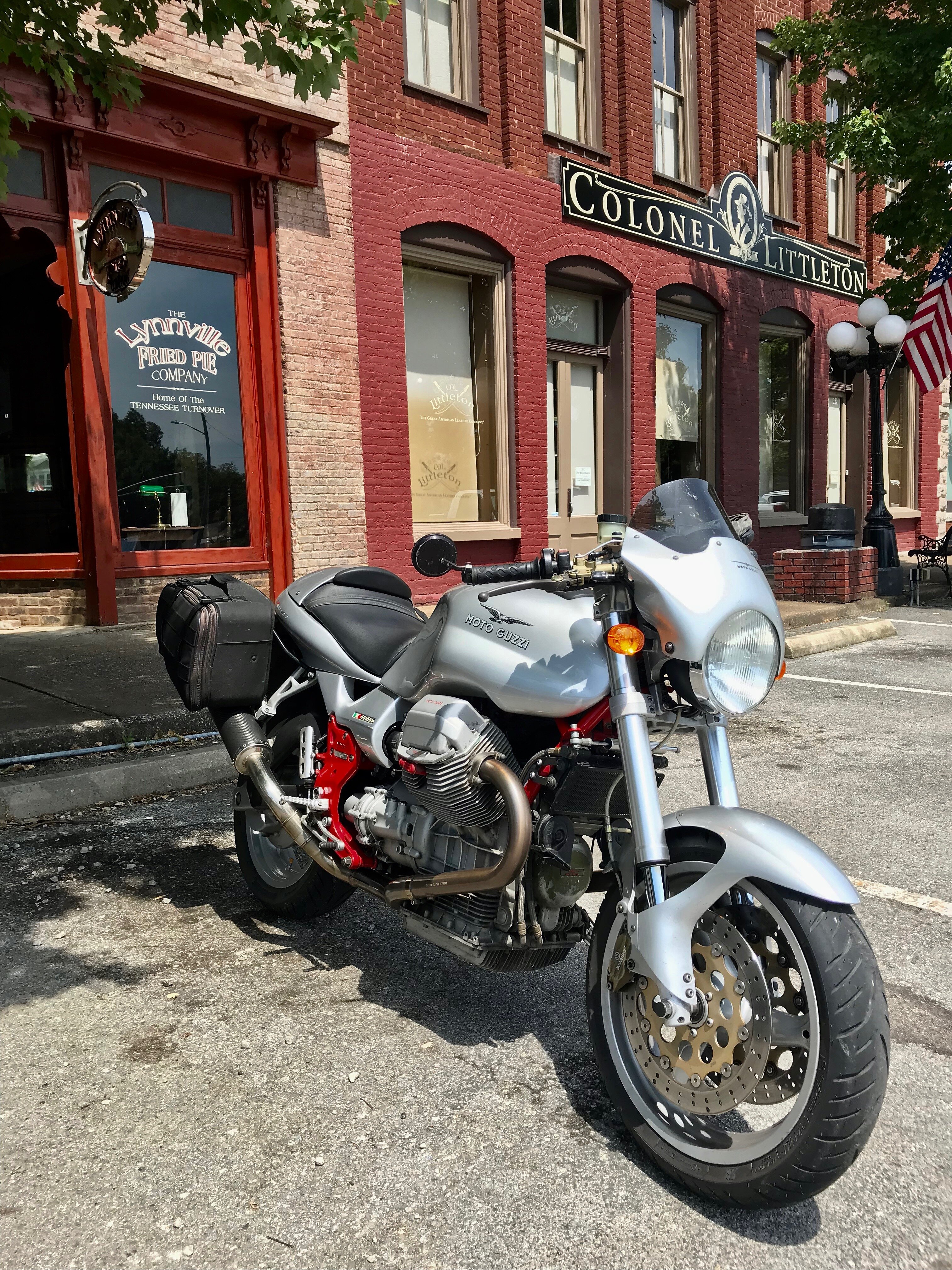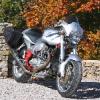-
Posts
20,491 -
Joined
-
Last visited
-
Days Won
1,188
Content Type
Profiles
Forums
Events
Gallery
Community Map
Everything posted by docc
-
Here's one of the more coherent posts on bearing load from Pete Roper: Rear Wheel Woes 22 July 2005 And a thread on the spacer length and bearing failure by Baldini: Hot Rear End 27 July 2003
-
No question, you've done it the right way. I don't know that anyone has ever checked the difference torquing from the off side. Interesting theory on the water running downhill to the left bearing. But, can water get to the bearings inside the wheel? I don't know. Most every one has alleged that the 'sealed' bearing don't come with much grease in them from the factory. It is true, G2G, about the locking nut and probably wouldn't walk off. I would still be nervous about only using 1/4 the torque. Definitely not something I want on my mind at 150 kph. And I forget now what the opinions were about the short spacers. Mine checked out ok as well, but apparently some were a little short allowing a lateral stress on the bearing.
-
Aye, RL Heavy: all the "moly"- all the love . . . (clean your vent, watch your fill level)
-
So, this is some curious inter-metric conversion: a guy (uh, dat's me:nerd:) makes a 1.00 mm error; he (dat's me:o) owes Mick a pint. And raz, too. Really, he (dat's me So, this is rather convoluted/forum conversion math: 1.00 mm x 1 (24/7) forum = 5 pints. Since we ('mericans) can only get good ale in 12 ounce bottles, I'm pretty sure I drank all five pints today just lamenting over the Little Nipple Affair. None-the-less, I am so behind on my bar tab form the South'n Spine Raid that I will buy you a beer at the mere mention of *Little Nipples* any where in the world. From now on. Oh, for goodness sake, be discreet . . .
-
You and Mick have been very kind about the "Little Nipple Affair.":rolleyes: What a difference a silly millimeter can make! I looked in my Owner's Manual, as well, which calls for 12 Kgm for the rear axle. This conversion makes that 86.8 lb-ft (118 NM). My **stars**, I could be haunted by the Littlle Nipple Affair. I think I might owe everyone on the forum a pint. Let me know when you're in the neighborhood . . . BYON (Bring Your Own Nipples)
-
I would be rather afraid that my rear axle might "walk off" at 30NM. Also, gstallons, some have noted a 'short' spacer in the rear axle leading to perceived early bearing failures. In the end size may (or may not ) matter. You would think it a simple thing: "What torque, the axles?"
-
I don't think I've ever actually put my torque wrench on the "housing side." But now we know just what kind of nut cases have red-frame silver Sports!
-
You have my PM. I'm emailing your pint. If I don't make good on this, Luhbo will never forgive me.
-
According to the Workshop Manual, 30 NM would be the torque for an 8mm fastener (about 22 lb-ft). Some have tried to tighten the rear like the front (90-100), but there have been some opinions that the extra torque (120NM) helps reduce bearing failure. In this case, I'd have to say, "yes, I'm sure about this." But, I for one, appreciate the way the forum works in checks and balances as we discuss and consider postings.
-
Front: 90-100 NM (66.4-73.8 Lb-Ft) Rear: 120 NM "housing side" (88.5 Lb-Ft)
-
That would be my mistake. PM me, I'll stand up for it.
-
Yes, yes. I measured the wrong adapter tap. It is, in fact, 6mm x 1.00. Good catch and thank you!
-
That is very well put. I may have made it sound like I tune "by ear" or some such. Not so. In the beginning, the bike was "tuned" by the selling dealer. Their approach was, "it starts, it runs, don't mess with it." I then began to use the compendium of procedures in Guzziology using my shop manual for reference; Followed then by the JeffinOhio system; finally appended by the (pinned) forum discussion. After about ten tune-ups, I've found the parameters get closer and closer and she runs better and better. Over the years, I've sen the "tune-up" solve some horrendous impressions of terminal mechanical and electrical failure. It is notable, though, that the answer to "setting the idle" becomes: perform a full tune up including valve adjustment. Yet, after you've got this accomplished, you can turn the little screw.
-
Hi, Hubert! Thank you for your conversation! I find my shop manual lacking in several usable components. Chiefly, I cannot measure "degrees of opening" and need the conversion tables for mV to set the TPS. There are other confusions in the manual procedure which is very brief. Reviewing the "Forum Procedure", I can't say I follow this procedure entirely either. I'm thinking the "tuning" is more like playing a musical instrument than just following a given "procedure." I think, Hubert, you and I could make some beautiful *music* together!
-
The US models had brass nipples for the carbon fuel evaporative canisters. These were in the tool tray under the seat on early Sports and plumbed with 20 feet (yes, twenty feet) of fuel line. The whole contraption weighs five pounds. Many owners removed the apparatus and either hooked a vacuum line between the two intake ports or simply plugged the ports with a threaded fastener (I'm assuming non-US bikes just had the the cross head screws). The trouble I found after removing and replacing the bolts to thread in vacuum taps for balancing every 4000-6000 miles is that the aluminum threads gave up in the intake. I've gone back to permanent brass nipples with rubber caps in place.
-
Antonio, I'm pretty sure you mean "0.20mm" for both intake and exhaust. That is (roughly) 0.008 inch. 0.15mm/0.20mm is equivalent to 0.006/0.008 inch which is the most common response so far.
-
Who can make these polls on the forum now? This would be a good one (for motorheads) (in winter) . . .
-
I found this to be true as well. There is not an advantage to using both idle stops to have any synchronization. It is, in fact, better to back the right screw fully out and use only the left and the tension in the linkage rod to make balance at idle. (I've done it both ways). There remains the debate about 1) what is "idle" (since the tachometer might be 200-300 rpm high, or even 500 over; and 2) should idle be balanced with the air bypass? ( I think not, but, others disagree). I suppose, if one wanted to just crank the idle speed up, and not mess around with "tuning", it would be easiest done with the left screw as it is the easiest to get to.
-
I smell a poll coming . . . "how do set your V11 valve lash? a- 0.002/0.004 b- 0.004/0.006 c- 0.006/0.008 d- 0.008/0.010 (I vote"c")
-
The threading is 5mm diameter x 1.00 mm pitch. It would be the same for the thread repair kit. Don't ask . .
-
Well, Hubert, that depends. Some of these bikes have had their right idle stop defeated, in which case turning it will do nothing at all. Some procedures have used both the left and the right to set the throttle body balance at idle, in which case truning the right screw would affect the balance at idle due to play in the linkage rod. I would agree with you that once the TPS baseline is set at the correct idle rpm (not the tach indicated rpm ), and the throttle body balance is set, the idle can be changed to suit the rider or the conditions. One must still be aware of how the idle stops have been used in the balance procedure as this is not always the same and it is very common that the right side screw is completely backed out.
-
For sure, even with any changes you make, use the pinned TPS Procedure. All the values remain the same. I've said this before, but it's not uncommon that the early tachs read "optimistically" and a 1200 rpm reading could really be 900 (not high enough). Coming from a big block V-8 background, I've always loved the cam-lope idle, but the Guzzi (for several reasons) likes it higher. Just winding one or both of the idle screws is not a good idea. Not disastrous, mind you, just not good.
-
Actually, the Neutral Switch provides power to the Run Switch through the middle relay. If the bike will bump off then it is getting power to run. To complicate matters, the alternate power path to run is through the Sidestand Switch which does NOT go through a relay. So, with the bike in neutral and the sidestand up, you should hear the whir of the fuel pump. If then, thumbing the starter switch does nothing, the clutch switch is suspect. Try turning the bars back and forth attempting to rethumb the starter. Try spraying a contact cleaner between the switch and lever (or take the lever out and clean up the area without loosing the little puck or ball between the switch and lever). Finally, you might have to remove the tank and refit the bullet connectors for the clutch switch as they are notorious. If the bike is in neutral, sidestand up and you get nothing (no whir/nothing), put the stabnd down and try again. If she then starts, the trouble is either the Neutral Switch (try remove/clean/replace or switch to Redline gearlube or replace the switch) or it's the middle relay (make sure you have upgraded relays and the contacts are good; relay swapping or relay wiggling could help but is temporary). Just for kicks, note that the middle relay is called the "sidestand relay" but it is actaully activated by the neutral switch. Let us know what you find . . .
-
Some riders carry maps in their tankbag, but the Sport keeps that flow chart in its "map" pocket (and Carl Allison's wiring diagram)! No one is ever so lost as when their electrons cannot find their way!
-
On a brighter note:



